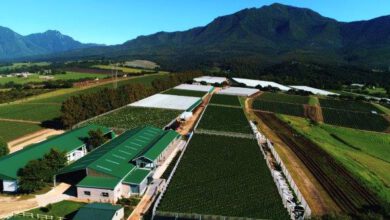DIDAS – A User-Friendly Program for Assisting Drip Irrigation Design And Scheduling
Shmulik Friedman
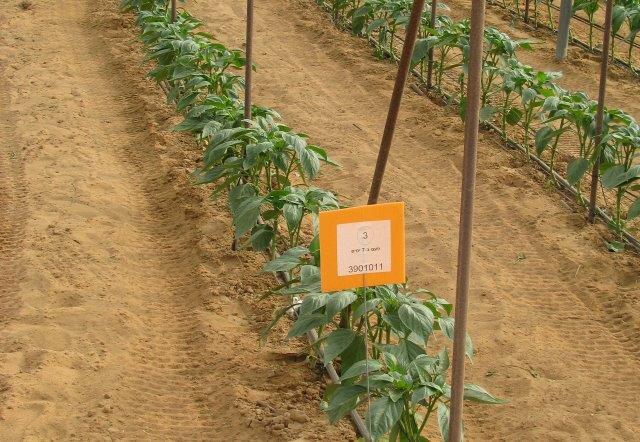
what is didas?
didas is a software package aimed at assisting irrigators in the design of drip-irrigation systems and in irrigation scheduling. the program simulates drip irrigation of various annual crops and trees in various soils under different conditions of evaporation. it evaluates plant water-use efficiency, but not plant growth or yield.
didas is comprised of three modules:
a drip-system design tool based on steady irrigation and water-uptake processes to assess the effect of geometrical attributes on water-use efficiency.
a diurnal pattern module, based on steady irrigation and accounting for the diurnal patterns of plant-atmosphere resistance to water uptake and evaporation, serving for fine-tuning of the irrigation-system design and for preliminary evaluation of scheduling scenarios.
an irrigation-scheduling optimization tool, based on the actual water application schedule and on the diurnal pattern of the plant-atmosphere resistance to water uptake.
who should use didas?
didas is intended for both practitioners and scholars. potential users include private growers and irrigators working for irrigation companies, extension services and growers’ associations. it is also of benefit to researchers, lecturers and students interested in the processes of two and three-dimensional water flow and uptake in soils.
an updated didas version can be downloaded freely from https://app.agri.gov.il/didas.
what is didas good for ?
irrigators of annual and perennial crops can use didas as a decision-support tool for assistance in selecting optimal designs of drip-irrigation systems and optimal irrigation schedules, where water is a key limiting factor in crop production. the program can serve as both a benchmark tool for assessing and comparing existing system designs and irrigation schedules and for developing new, water-use-efficient designs and schedules.
“design” does not refer to the hydraulics of the irrigation system (pumps, valves, filters, pipe diameters, and the like), but rather to the geometrical attributes of the drip-irrigation system. these include: distances between emitters along drip lines and between drip lines, the depth of subsurface emitters, and the size and depth of root systems. didas assesses the effects of these attributes on the plant’s water-use efficiency under various environmental conditions (soil properties and atmospheric evaporative demand). didas refers directly to only drip irrigation. nevertheless, its three modules can also assist in understanding and assessing furrow irrigation, for example, by simulating irrigation with parallel line sources on a flat soil surface.
.jpg) |
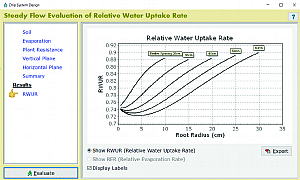 |
|
figure 1. didas window (of the design module) depicting the horizontal plane. the planar scenario involves point sources/sinks and a rectangular array of coupled emitters and plants, with drip lines spaced at 80 cm, and spacing between emitters along the drip lines increasing from 20 cm, in increments of 10 cm. |
figure 2. the design module output window presenting the relative water-uptake rate (rwur) as a function of the radius of the conceived root zone for five emitter spacings of 20 to 60 cm, assuming no evaporation from the soil surface and no plant−atmosphere resistance to water uptake. |
“scheduling” refers to, and assists in optimizing drip-irrigation schedules for both ‘every-few-days’ irrigation and multiple daily irrigation pulses. didas evaluates the effects of irrigation frequency, daily hours of water application and irrigation-pulse duration on water-use efficiency for a given scenario of drip system design, soil properties, root system size and depth, and atmospheric evaporative demand. didas cannot be used to assess plant water-use efficiency in rain-fed crop production or when applying supplemental irrigation, i.e., it refers only to regular irrigation schedules.
researchers, lecturers and students can use didas as a research or training tool for studying the effects of various boundary (engineering and environmental) conditions on the processes oftwo- and three-dimensional water flow and uptake in variably saturated soils. setting scenarios of coupled, on-surface or subsurface water sources and subsurface sinks, and utilizing the graphical outputs of the spatial distributions and temporal patterns of soil water potential enable methodological studies of theroles of gravity and capillarity in driving the soil water, and of the effects of soil, plant and atmospheric evaporative demand on water flow and uptake by plant roots. didas also allows setting scenarios with only point or line water sources and not water sinks. these scenarios are relevant to other agronomic and environmental practices and to processes involving water application and leaks with no water uptake by plant roots.
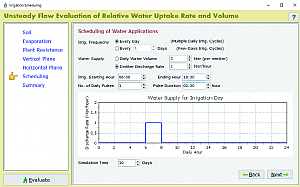 |
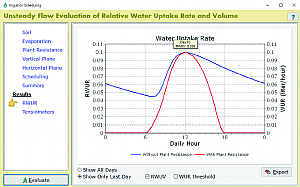 |
|
figure 3. didas window depicting irrigation scheduling under the scenario of a single daily irrigation between 0600 and 0800 h, emitter discharge rate of 1 l h-1, and 10simulated irrigation days. |
figure 4. didas irrigation-scheduling output window,depicting the diurnal variation of the relative water-uptake rate (rwur) on the 10th simulated day, as evaluated with the unsteady flow and uptake module. displayed are: red –rwur taking into account the defined plant−atmosphere resistance to water uptake; blue – rwurs as evaluated on the assumption of no plant |
what are didas’ concepts and principles?
didas is designed to be user-friendly and to use a minimal number of readily available and intuitive parameters, while at the same time maintaining accuracy, robustness and relevance. the program performs computations based on analytical solutions of the relevant linearized water flow and uptake problems. water flow is described by the superposition of solutions for positive sources (on-surface or subsurface emitters) and negative sinks (plant root systems). steady water flow is assumed in the design module and unsteady flow is used in the irrigation-scheduling module. the design tool is based on a new, relative water-uptake rate criterion (rwur, ratio between water uptake rate and irrigation rate) suggested for assessing the effect of the geometrical attributes on water use efficiency. the recommended rwur criterion for design purposes is evaluated under the assumption of no plant−atmosphere resistance to water uptake. namely, the plant roots apply maximum possible suction and the water uptake is determined only by the capability of the soil to conduct water from the sources (emitters) to the sinks (root zones). the computations of the rwur require only three parameters describing soil texture, root-zone size, and potential evaporation in those few cases where it is important to account for evaporation from the soil surface.
the irrigation-scheduling optimization tool is based on modeling unsteady water flow and on a relative water-uptake volume criterion (rwuv, ratio between daily water-uptake volume and daily irrigation volume). an alternative optimization criterion is maximization of the daily hours for which the evaluated (absolute) water-uptake rate is higher than a given threshold value. the computations of diurnal patterns of water-uptake rates and daily rwuv for a given irrigation scenario require additional information on the daily pattern of the plant-atmosphere resistance to water uptake and on the hydraulic conductivity of the soil.
shmulik friedman, gregory communar and alon gamliel, department of environmental physics and irrigation, institute of soil, water and environmental sciences (aro), the volcani center, rishon lezion 7505101, israel, didas@agri.gov.il



